For more content, Click Here and experience this XYHor in its entirety!Space...the Final Frontier. Let's boldly go where few have gone before with XYHor: Space: Astronomy & Spacefaring: the collection of the latest finds and science behind exploring our solar system, how we'll get there and what we need to be prepared for!
128 posts
Latest Posts by xyhor-astronomy - Page 3




North Cascades National Park, Washington
A night in the Cascade Mountains
Secret Chamber? Cosmic Rays Reveal Possible Void Inside Great Pyramid

A large void has been discovered inside the Great Pyramid of Giza, thanks to cosmic rays. If the large space turns out to exist, its function — which could be anything from new chamber to sealed-off construction passage — is likely to be the source of much archaeological debate.
An international group of researchers reported today (Nov. 2) in the journal Nature that by tracking the movements of particles called muons, they have found an empty space more than 98 feet (30 meters) long that sits right above the granite-walled Grand Gallery within the massive pyramid. The Great Pyramid, also known as Khufu’s pyramid, was built during that pharaoh’s reign between 2509 B.C. and 2483 B.C. No new rooms or passages have been confirmed inside the pyramid since the 1800s.
“The void is there,” said Mehdi Tayoubi, the president of the organization Heritage Innovation Preservation and a leader of the ScanPyramids mission, an ongoing effort to bring new technology to bear on Egypt’s most famous structures. Read more.
What’s Up November 2017
What’s Up For November?
Dawn pairing of Jupiter and Venus, Moon shines near star clusters, meteor activity all month long!

This month binoculars will come in handy–to view the moon, star clusters, and a close pairing of Venus and Jupiter.

You can’t miss bright Venus in the predawn sky. This month Venus pairs up with Jupiter on the morning of November 13th.

The Leonids peak on a moonless November 17th. Expect no more than 10 meteors an hour around 3:00 a.m., the height of the shower.

The Northern and Southern sub-branches of the Taurid meteor shower offer sparse counts of about 5 meteors per hour, but slow, bright meteors are common.

The nearby November Orionids peak on the 28th. In contrast to the Taurids, the Orionids are swift. But don’t expect more than 3 meteors per hour.

The moon glides by three beautiful star clusters in the morning sky this month, and a pair of binoculars will allow you to see the individual stars in the clusters. Aim your binoculars at the Pleiades and the moon on the 5th.

Then aim at the Messier or M-35 cluster and the moon on the 7th and the Beehive cluster and the moon on the 10th.

Meanwhile, at dusk, catch Saturn as it dips closer to the western horizon and pairs up with Mercury on the 24th through the 28th.

Also, Comet C/2017 O1 should still be a binocular-friendly magnitude 7 or 8 greenish object in November. Use Polaris, the North Star as a guide. Look in the East to Northeast sky in the late evening.
Watch the full What’s Up for November Video:
Make sure to follow us on Tumblr for your regular dose of space: http://nasa.tumblr.com.

Should there be a holiday called Astronomy Day?
Where lights are to be turned off for the entire night so everyone could see the stars?

The Extraordinary Core of a Neutron Star
Lucy Reading-Ikkanda/Quanta Magazine; Source: Feryal Özel







10 Spacetime Mysteries That Quantum Gravity Could Solve
“4.) In most approaches to quantum gravity, space-time is not fundamental but made of something else. That might be strings, loops, qbits, or some variant of space-time “atoms” which appear in condensed-matter based approaches. The individual constituents, however, can only be resolved when probed with extremely high energies, far beyond what we can achieve on Earth.”
What is the fundamental nature of the Universe? When it comes to General Relativity, our answer is matter and energy on one hand, and spacetime on the other. But there’s another side to that story: a quantum one. While matter and energy can be discretized into quanta, our notion of spacetime is purely classical. But depending on what our true, fundamental theory of quantum gravity actually is, it could have incredible implications for our Universe. Perhaps we have tiny little black holes popping in and out of existence on a continuous basis; perhaps the vacuum of space isn’t entirely transparent to light; perhaps time turns into space at some level; perhaps wormholes and baby Universes are real. These are mysteries that are currently unresolved, but quantum gravity could provide the answer.
What are the mysteries, and what does it all mean? Sabine Hossenfelder explores, with a fantastic video!

2017 October 30
Orionid Meteors from Orion Image Credit & Copyright: Lu Shupei
Explanation: Meteors have been shooting out from the constellation of Orion. This was expected, as October is the time of year for the Orionids Meteor Shower. Pictured here, over a dozen meteors were caught in successively added exposures last weekend over Wulan Hada volcano in Inner Mongolia, China. The featured image shows multiple meteor streaks that can all be connected to a single small region on the sky called the radiant, here visible just above and to the left of the belt of Orion, The Orionids meteors started as sand sized bits expelled from Comet Halley during one of its trips to the inner Solar System. Comet Halley is actually responsible for two known meteor showers, the other known as the Eta Aquarids and visible every May. Next month, the Leonids Meteor Shower from Comet Tempel-Tuttle should also result in some bright meteor streaks.
∞ Source: apod.nasa.gov/apod/ap171030.html


What are Pulsars?
Pulsars are spherical, compact objects that are about the size of a large city but contain more mass than the sun. Discovered in 1967, pulsars are fascinating members of the cosmic community.
From Earth, pulsars often look like flickering stars. On and off, on and off, they seem to blink with a regular rhythm. But the light from pulsars does not actually flicker or pulse, and these objects are not actually stars.
Pulsars radiate two steady, narrow beams of light in opposite directions. Although the light from the beam is steady, pulsars appear to flicker because they also spin. It’s the same reason a lighthouse appears to blink when seen by a sailor on the ocean: As the pulsar rotates, the beam of light may sweep across the Earth, then swing out of view, then swing back around again. To an astronomer on the ground, the light goes in and out of view, giving the impression that the pulsar is blinking on and off. The reason a pulsar’s light beam spins around like a lighthouse beam is that the pulsar’s beam of light is typically not aligned with the pulsar’s axis of rotation.
Click here to see the animation
Click here to hear the pulsars sound

A slow-motion animation of the Crab Pulsar taken at 800 nm wavelength (near-infrared) using a Lucky Imaging camera from Cambridge University, showing the bright pulse and fainter interpulse.
Credit: Cambridge University Lucky Imaging Group
Oldest recorded solar eclipse helps date the Egyptian pharaohs

UNIVERSITY OF CAMBRIDGE—Researchers have pinpointed the date of what could be the oldest solar eclipse yet recorded. The event, which occurred on 30 October 1207 BC, is mentioned in the Bible, and could have consequences for the chronology of the ancient world.
Using a combination of the biblical text and an ancient Egyptian text, the researchers were then able to refine the dates of the Egyptian pharaohs, in particular the dates of the reign of Ramesses the Great. The results are published in the Royal Astronomical Society journal Astronomy & Geophysics.
The biblical text in question comes from the Old Testament book of Joshua and has puzzled biblical scholars for centuries. It records that after Joshua led the people of Israel into Canaan - a region of the ancient Near East that covered modern-day Israel and Palestine - he prayed: “Sun, stand still at Gibeon, and Moon, in the Valley of Aijalon. And the Sun stood still, and the Moon stopped, until the nation took vengeance on their enemies.” Read more.
Solar System: 10 Things to Know This Week...Halloween Edition!
This week, we’re getting into the Halloween spirit with 10 spooktacular things to let your imagination run wild.

It’s not Halloween without our favorite scary characters, but what if they could stop bothering us Earthlings and go far, far away? We begin with where Dracula, Frankenstein, and other creepy creatures might choose to live if the galaxy were theirs to claim…
1. The dark (k)night.

The prince of darkness himself, Dracula, can finally seek sweet respite from the Sun. We think he’d love to live on a rocky planet named YZ Ceti d that orbits so close to its red star that it’s tidally locked keeping one side of the planet in perpetual nighttime and the other side in perpetual daytime, with a brilliant red sky (though we can guess which side Dracula will prefer).
2. Where art thou, werewolves?

Home sweet home for our furry Full Moon friends might just be on Trappist-1, a planetary system with seven planets—and where standing on one planet would mean the other planets look like six moons (some as big as our Moon in the sky).
3. Left in the dust.

We couldn’t think of anyone better to live on Proxima b than The Mummy. Hopefully this ancient monster can finally rest in peace on an exoplanet that scientists theorize is a desert planet once home to ancient oceans.
4. Cloudy with a chance of Frankenstein.

One scientific experiment we’d like to conduct: whether Frankenstein would rather live on HAT-P-11b or Kepler-3b, theorized to have fierce thunderstorms and lightning.
5. The walking dead.

We’re pretty confident that if zombies were to pick a planet, they’d want one that shares their love of death and destruction. We think they’d feel right at home on one of the pulsar planets, which are scorched by radiation because they orbit a dead star.
6. Rest your weary bones.

Skeletons need look no further: Osiris, an exoplanet that’s so close to a star that it’s “losing its flesh” as the star destroys it, seems like a perfect match.
7. Enough of the scary stuff.

For kids out there, turn pumpkin decorating into an out-of-this-world activity with space-themed stencils, from Saturn to the Sun.
8. Spooky sounds.

Cassini’s radio emissions from Saturn could give creaky doors and howling winds a run for their money. Listen to the eerie audio recordings here and find more HERE.
9. Pumpkin-carve like a NASA engineer.

NASA engineers design and build robots that can fly millions of miles to study other planets for a living—so on Halloween, they can’t help but bring that creative thinking to the grand old tradition of pumpkin carving. Take a cue from their creations with these insider tips.
10. Detective for a day.

From blades of ice on Pluto to a fuzzy, white “bunny” photographed on Mars, become a solar system sleuth and see if you can solve the stellar mysteries in this slideshow (then compare with how scientists cracked the case).
Make sure to follow us on Tumblr for your regular dose of space: http://nasa.tumblr.com.

Ghost Nebula
evosia Chasing auroras is much like living life: if you show up, always be prepared for the amazing to happen.
Density puts things in their proper places.
Space Station flight from a clear North Africa over a story Mediterranean
Solar System: Things To Know This Week
Weather permitting, you can observe the Moon most nights, unless it’s a new moon, when the lighted side of the Moon faces away from Earth. The Moon is by far the brightest object in the night sky and there’s plenty to see. But this week is special…

…October 28 is International Observe the Moon Night (also known as InOMN).
Here’s all you need to know to join in and celebrate:
1. One Planet. One Moon. One Night.

Everyone on Earth is invited to join the celebration by hosting or attending an InOMN event and uniting on one day each year to look at and learn about the Moon together.
2. What’s Up?

October’s night skies are full of sights, from the first quarter Moon on InOMN to Saturn making a cameo appearance above the Moon October 23 and 24. Watch our What’s Up video for details.
3. Be Social

Hundreds of events are planned around the globe. Click the top link on this page for a handy map. You can also register your own event.
4. Don’t Just Stand There

Here are some activities for enhanced Moon watching.
5. Impress Your Friends with Moon Knowledge

Download InOMN flyers and handouts, Moon maps and even some pre-made presentations. There’s even a certificate to mark your participation.
6. Guide to the Face of the Moon

Almost dead center on the Earth-facing side of the Moon is the Surveyor 6 robotic spacecraft impact side. Apollo 12 and 14 are a bit to the left. And Apollo 11 - the first steps on the moon - are to the right. This retro graphic tells the whole story.
7. Moon Shots

NASA photographers have done some exceptional work capturing views of the Moon from Earth. Here are a few galleries:
You can’t have a solar eclipse without the Moon.
The 2016 “Supermoon” was pretty spectacular.
The Moon gets eclipsed, too.
That IS a Moon - AND the International Space Station.
The Moon is always a great photo subject.
Some spooky shots of the 2014 “Supermoon.”
And 2013.
Tips from a NASA pro for photographing the Moon.
8. Walking on the Moon

Twelve human beings walked on the face of the Moon. Here are some of the best shots from the Apollo program.
9. Moon Watch

Our Lunar Reconnaissance Orbiter is up there right now, mapping the moon and capturing some spectacular high-resolution shots.
10. Keep Exploring

Make our Moon portal your base for further lunar exploration.
Check out the full version of ‘Ten Things to Know This Week’ HERE.
Make sure to follow us on Tumblr for your regular dose of space: http://nasa.tumblr.com.

Black Holes are not so Black (Part 3) - Gravitational Waves
The existence of Gravitational Waves have been confirmed. But you probably have heard that. In this post, we will break down this profound discovery into comprehend-able chunks.
This is going to be a amazing journey. Ready ?
Redefining Gravity
When we usually talk of Gravitation we are bound to think like Newton, where objects are assumed to exerting a force upon each other.
Like imaginary arrows of force in space. But this picture, although good for high school crumbled, with the advent of Einstein’s theory of Relativity.

What is the Space-Time Fabric?
Think of space-time fabric as an actual cloth of fabric. ( An analogy )
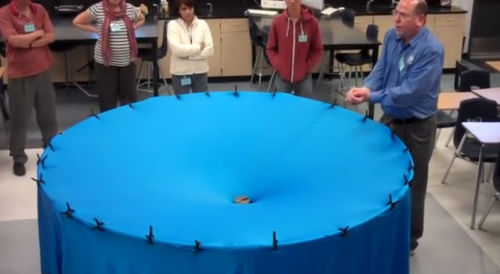
When you place an object on the fabric, the cloth curves. This is exactly what happens in the solar system as well.

The sun with such a huge mass bends the space-time fabric. And the earth and all the planets are kept in orbit by following this curvature that has been made by the sun.
Attributing to the various masses of objects, the way they bend this fabric also varies.
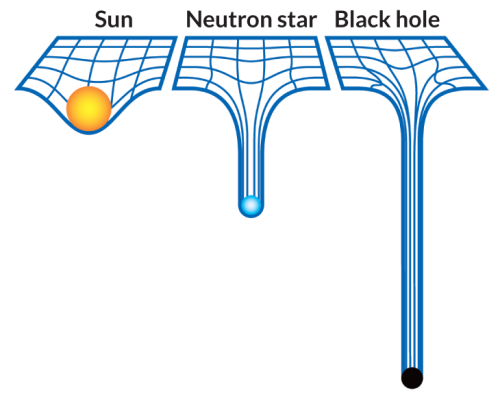
What are Gravitational Waves?
If you drop an object in a medium such as water, they produce ripples that propagate as waves through the medium.

Similarly, Gravitational waves are ripples in space-time fabric produced when you drag heavy objects through space time.
And the nature of these waves is that they don’t require a medium to propagate.
How do you make one?
Everything with mass/energy can create these waves.

Source
Two persons dancing around each other in space too can create gravitational waves. But the waves would be extremely faint.
You need something big and massive accelerating through space-time in order to even detect them.

And orbiting binary stars/black holes are valuable in this retrospect.
How can you detect them?
Let’s turn to the problem to detecting them assuming you do find binary stars/black-holes in the wondrous space to suite your needs.
Well, for starters you cannot use rocks/ rulers to measure them because as the space expands and contracts, so do the rocks. ( the distances will remain same in both the cases )

Here’s where the high school fact that the speed of Light is a constant no matter what plays an important and pivotal role.
If the space expands, the time taken for light to reach from A to B would be longer. And if it contracts, the time taken for it to reach from A to B would be smaller.

PC: PHDComics
By allowing the light waves from the contraction and expansion to interfere with each other, such as done in any interferometry experiment we can detect the expansion or contraction. Voila!
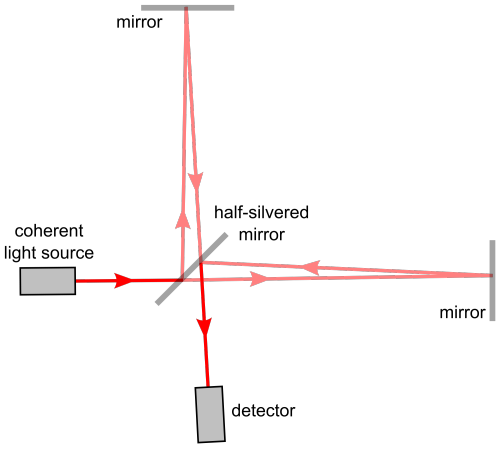
And this is exactly what they did! ( on a macroscopic level ) at LIGO (Laser Interferometer Gravitational-Wave Observatory)
14 September 2015

Two Black Holes with masses of 29 and 36 solar masses merged together some 1.3 Billion light years away.
Two Black Holes colliding is the header animation of the ‘Black Holes are not so Black Series’, in case if you haven’t noticed.

The merger of these two black holes results in the emission of energy equivalent to 3 solar masses as Gravitational Waves.
This signal was seen by both LIGO detectors, in Livingston and Hanford, with a time difference of 7 milliseconds.
And with the measurement of this time difference, physicists have pronounced the existence of Gravitational Waves.
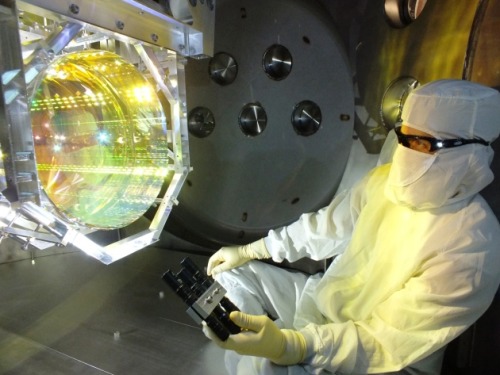
Source
All this is most certainly easily said than done and requires meticulous and extensive research, not to mention highly sensitive instruments.
Had they not have measured this time difference, we might have had to wait for the merger for more massive black holes to collide and maybe even build more sensitive instruments to detect these waves.
And Einstein predicted this a 100 years back!
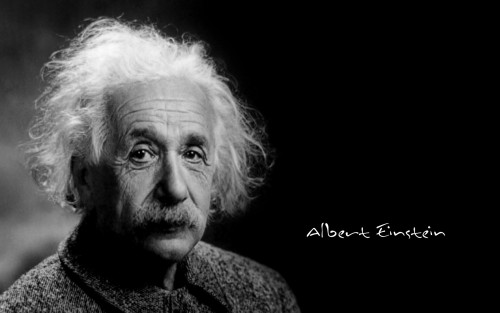
Mind Blown!
Note: Hope you are able to understand and appreciate the profundity of the discovery done by mankind.
** All animations used here are merely for Educational purposes. If you have any issues, please write to us at : 153armstrong@gmail.com
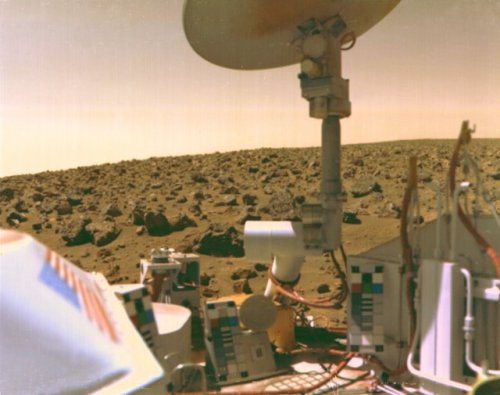
A boulder-strewn field of red rocks stretches across the horizon in this self-portrait of Viking 2 on Mars’ Utopian Plain. Viking 2 landed Sept. 3,1976, some 4,600 miles from the twin Viking 1 craft, which touched down on July 20.
Image Credit: NASA/JPL

The Space Shuttle Challenger at a foggy Cape Canaveral, 1984.
(NASA/Department of Defense)
![Andromeda [x]](https://64.media.tumblr.com/aa70ce40e59ba0f9da6e334afac731fe/tumblr_ox11noOQXn1tuy5mao1_500.jpg)
Andromeda [x]
js

False color image of Uranus taken with the Hale Telescope and the Palomar Observatory. The rings are the red pieces.
Image credit: Palomar Observatory & Hale telescope

A false-color image of the mid-infrared emission from the Great Galaxy in Andromeda, as seen by Nasa’s WISE space telescope.
Credit: NASA/JPL-Caltech/WISE Team
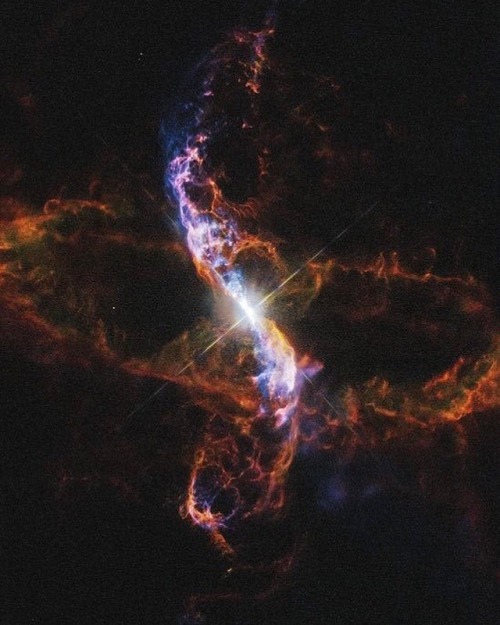
R Aquarii is known as a symbiotic star made up of a white dwarf–red giant binary pairing. These two stars are tied in orbit around one another with a period of around 44 years. The primary star is a variable red giant, meaning it changes temperature and undergoes drastic brightness fluctuations. The secondary star is a white dwarf that sucks in material from the red giant. Some of the extra material is sometimes ejected, forming the incredibly stunning nebula surrounding it.
(Credit: Hubble Space Telescope/Judy Schmidt)

When (Neutron) Stars Collide via NASA http://ift.tt/2hK4fP8
What’s the deal about gravitational waves?
I guess y’all have heard about the discovery gravitational waves, and the recent observation of gravity waves linked to a visual observation as well.
What are they?
Gravitational waves are disturbances in space-time that are caused by objects in motion. Objects with mass distort spacetime, and thus when they move they also create disturbances. Think moving your hand along the surface of a pond - your hand’s motion creates waves and ripples in the water. Gravity waves were theorized by Einstein when he published his paper on General Relativity in the mid 1900s, and they were finally confirmed by LIGO about a year or two ago. The discovery of gravitational waves was considered the last major test of General Relativity, meaning that everything it’s predicted has held up to testing. As these gravity waves pass through space, they stretch it in one direction and compress it in the other. Check these two gifs out for a good visualization:



What is LIGO?
Ligo, or Laser Inferometer Gravity-wave Observatory, is one of three gravity wave observatories in the world. It works by splitting a laser into two perpendicular components. The light waves travel down long tunnels, bounce off a mirror, and recombine at the intersection. The interference pattern of the two light waves is measured (interference is how two light waves interact with each other - if the peaks and troughs line up, they cancel, but if the peaks line up they add together). When a gravitational wave passes by, it stretches everything in one direction while compressing it in the other direction, then vice versa. This causes a change in the interference pattern, which is then measured. Here’s a good diagram:

If you want more information about gravity waves, check out these videos:
Sources: Image 1 2 3 4, check out the links for good explanations.
Let me know if y’all have any questions!!! I’m happy to answer them.

The missing links between galaxies have finally been found. This is the first detection of the roughly half of the normal matter in our universe – protons, neutrons and electrons – unaccounted for by previous observations of stars, galaxies and other bright objects in space.
How to Discover a Planet: A short step-by-step guide on how each of our planetary neighbors were originally discovered.
Why Webb Needs to Chill
Our massive James Webb Space Telescope is currently being tested to make sure it can work perfectly at incredibly cold temperatures when it’s in deep space.
How cold is it getting and why? Here’s the whole scoop…
Webb is a giant infrared space telescope that we are currently building. It was designed to see things that other telescopes, even the amazing Hubble Space Telescope, can’t see.

Webb’s giant 6.5-meter diameter primary mirror is part of what gives it superior vision, and it’s coated in gold to optimize it for seeing infrared light.

Why do we want to see infrared light?
Lots of stuff in space emits infrared light, so being able to observe it gives us another tool for understanding the universe. For example, sometimes dust obscures the light from objects we want to study – but if we can see the heat they are emitting, we can still “see” the objects to study them.
It’s like if you were to stick your arm inside a garbage bag. You might not be able to see your arm with your eyes – but if you had an infrared camera, it could see the heat of your arm right through the cooler plastic bag.

Credit: NASA/IPAC
With a powerful infrared space telescope, we can see stars and planets forming inside clouds of dust and gas.

We can also see the very first stars and galaxies that formed in the early universe. These objects are so far away that…well, we haven’t actually been able to see them yet. Also, their light has been shifted from visible light to infrared because the universe is expanding, and as the distances between the galaxies stretch, the light from them also stretches towards redder wavelengths.
We call this phenomena “redshift.” This means that for us, these objects can be quite dim at visible wavelengths, but bright at infrared ones. With a powerful enough infrared telescope, we can see these never-before-seen objects.

We can also study the atmospheres of planets orbiting other stars. Many of the elements and molecules we want to study in planetary atmospheres have characteristic signatures in the infrared.

Because infrared light comes from objects that are warm, in order to detect the super faint heat signals of things that are really, really far away, the telescope itself has to be very cold. How cold does the telescope have to be? Webb’s operating temperature is under 50K (or -370F/-223 C). As a comparison, water freezes at 273K (or 32 F/0 C).
How do we keep the telescope that cold?
Because there is no atmosphere in space, as long as you can keep something out of the Sun, it will get very cold. So Webb, as a whole, doesn’t need freezers or coolers - instead it has a giant sunshield that keeps it in the shade. (We do have one instrument on Webb that does have a cryocooler because it needs to operate at 7K.)

Also, we have to be careful that no nearby bright things can shine into the telescope – Webb is so sensitive to faint infrared light, that bright light could essentially blind it. The sunshield is able to protect the telescope from the light and heat of the Earth and Moon, as well as the Sun.

Out at what we call the Second Lagrange point, where the telescope will orbit the Sun in line with the Earth, the sunshield is able to always block the light from bright objects like the Earth, Sun and Moon.

How do we make sure it all works in space?
By lots of testing on the ground before we launch it. Every piece of the telescope was designed to work at the cold temperatures it will operate at in space and was tested in simulated space conditions. The mirrors were tested at cryogenic temperatures after every phase of their manufacturing process.

The instruments went through multiple cryogenic tests at our Goddard Space Flight Center in Maryland.

Once the telescope (instruments and optics) was assembled, it even underwent a full end-to-end test in our Johnson Space Center’s giant cryogenic chamber, to ensure the whole system will work perfectly in space.

What’s next for Webb?
It will move to Northrop Grumman where it will be mated to the sunshield, as well as the spacecraft bus, which provides support functions like electrical power, attitude control, thermal control, communications, data handling and propulsion to the spacecraft.

Learn more about the James Webb Space Telescope HERE, or follow the mission on Facebook, Twitter and Instagram.
Make sure to follow us on Tumblr for your regular dose of space: http://nasa.tumblr.com.

Oct. 4, 1957 - Sputnik, the Dawn of the Space Age via NASA http://ift.tt/2hNf1Yq
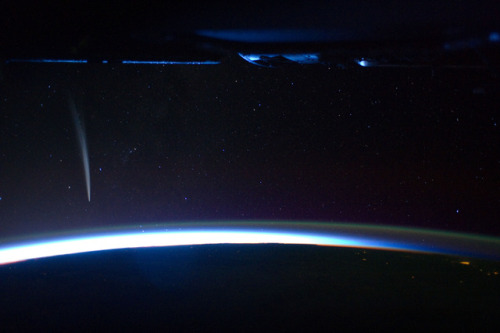
Comet Lovejoy is visible near Earth’s horizon in this nighttime image photographed by NASA astronaut Dan Burbank, Expedition 30 commander, onboard the International Space Station on Dec. 21, 2011.
Image credit: NASA